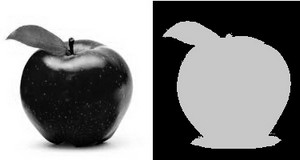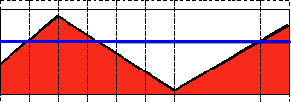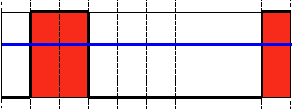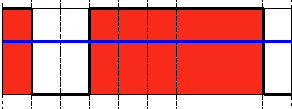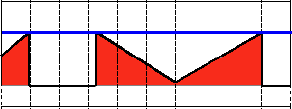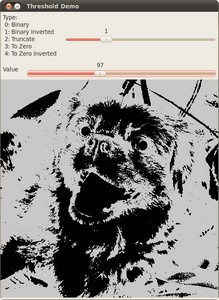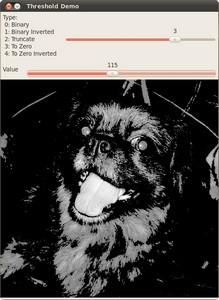import java.awt.BorderLayout;
import java.awt.Container;
import java.awt.Image;
import javax.swing.BoxLayout;
import javax.swing.ImageIcon;
import javax.swing.JFrame;
import javax.swing.JLabel;
import javax.swing.JPanel;
import javax.swing.JSlider;
import javax.swing.event.ChangeEvent;
import javax.swing.event.ChangeListener;
import org.opencv.core.Core;
import org.opencv.core.Mat;
import org.opencv.highgui.HighGui;
import org.opencv.imgcodecs.Imgcodecs;
import org.opencv.imgproc.Imgproc;
public class Threshold {
private static int MAX_VALUE = 255;
private static int MAX_TYPE = 4;
private static int MAX_BINARY_VALUE = 255;
private static final String WINDOW_NAME = "Threshold Demo";
private static final String TRACKBAR_TYPE = "<html><body>Type: <br> 0: Binary <br> "
+ "1: Binary Inverted <br> 2: Truncate <br> "
+ "3: To Zero <br> 4: To Zero Inverted</body></html>";
private static final String TRACKBAR_VALUE = "Value";
private int thresholdValue = 0;
private int thresholdType = 3;
private Mat src;
private Mat srcGray = new Mat();
private Mat dst = new Mat();
private JFrame frame;
private JLabel imgLabel;
public Threshold(String[] args) {
String imagePath = "../data/stuff.jpg";
if (args.length > 0) {
imagePath = args[0];
}
src = Imgcodecs.imread(imagePath);
if (src.empty()) {
System.out.println("Empty image: " + imagePath);
System.exit(0);
}
Imgproc.cvtColor(src, srcGray, Imgproc.COLOR_BGR2GRAY);
frame = new JFrame(WINDOW_NAME);
frame.setDefaultCloseOperation(JFrame.EXIT_ON_CLOSE);
Image img = HighGui.toBufferedImage(srcGray);
addComponentsToPane(frame.getContentPane(), img);
frame.pack();
frame.setVisible(true);
}
private void addComponentsToPane(Container pane, Image img) {
if (!(pane.getLayout() instanceof BorderLayout)) {
pane.add(new JLabel("Container doesn't use BorderLayout!"));
return;
}
JPanel sliderPanel = new JPanel();
sliderPanel.setLayout(new BoxLayout(sliderPanel, BoxLayout.PAGE_AXIS));
sliderPanel.add(new JLabel(TRACKBAR_TYPE));
JSlider sliderThreshType = new JSlider(0, MAX_TYPE, thresholdType);
sliderThreshType.setMajorTickSpacing(1);
sliderThreshType.setMinorTickSpacing(1);
sliderThreshType.setPaintTicks(true);
sliderThreshType.setPaintLabels(true);
sliderPanel.add(sliderThreshType);
sliderPanel.add(new JLabel(TRACKBAR_VALUE));
JSlider sliderThreshValue = new JSlider(0, MAX_VALUE, 0);
sliderThreshValue.setMajorTickSpacing(50);
sliderThreshValue.setMinorTickSpacing(10);
sliderThreshValue.setPaintTicks(true);
sliderThreshValue.setPaintLabels(true);
sliderPanel.add(sliderThreshValue);
sliderThreshType.addChangeListener(new ChangeListener() {
@Override
public void stateChanged(ChangeEvent e) {
JSlider source = (JSlider) e.getSource();
thresholdType = source.getValue();
update();
}
});
sliderThreshValue.addChangeListener(new ChangeListener() {
@Override
public void stateChanged(ChangeEvent e) {
JSlider source = (JSlider) e.getSource();
thresholdValue = source.getValue();
update();
}
});
pane.add(sliderPanel, BorderLayout.PAGE_START);
imgLabel = new JLabel(new ImageIcon(img));
pane.add(imgLabel, BorderLayout.CENTER);
}
private void update() {
Imgproc.threshold(srcGray, dst, thresholdValue, MAX_BINARY_VALUE, thresholdType);
Image img = HighGui.toBufferedImage(dst);
imgLabel.setIcon(new ImageIcon(img));
frame.repaint();
}
public static void main(String[] args) {
System.loadLibrary(Core.NATIVE_LIBRARY_NAME);
javax.swing.SwingUtilities.invokeLater(new Runnable() {
@Override
public void run() {
new Threshold(args);
}
});
}
}


